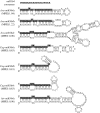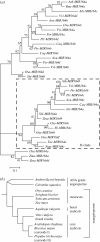The evolutionary-developmental analysis of plant microRNAs
- PMID: 20047873
- PMCID: PMC2838268
- DOI: 10.1098/rstb.2009.0246
The evolutionary-developmental analysis of plant microRNAs
Abstract
MicroRNAs (miRNAs) control many important aspects of plant development, suggesting these molecules may also have played key roles in the evolution of developmental processes in plants. However, evolutionary-developmental (evo-devo) studies of miRNAs have been held back by technical difficulties in gene identification. To help solve this problem, we have developed a two-step procedure for the efficient identification of miRNA genes in any plant species. As a test case, we have studied the evolution of the MIR164 family in the angiosperms. We have identified novel MIR164 genes in three species occupying key phylogenetic positions and used these, together with published sequence data, to partially reconstruct the evolution of the MIR164 family since the last common ancestor of the extant flowering plants. We use our evolutionary reconstruction to discuss potential roles for MIR164 genes in the evolution of leaf shape and carpel closure in the angiosperms. The techniques we describe may be applied to any miRNA family and should thus enable plant evo-devo to begin to investigate the contributions miRNAs have made to the evolution of plant development.
Figures




Similar articles
-
Insights from ANA-grade angiosperms into the early evolution of CUP-SHAPED COTYLEDON genes.Ann Bot. 2011 Jun;107(9):1511-9. doi: 10.1093/aob/mcr024. Epub 2011 Feb 13. Ann Bot. 2011. PMID: 21320879 Free PMC article.
-
An Evolutionary Framework for Carpel Developmental Control Genes.Mol Biol Evol. 2017 Feb 1;34(2):330-348. doi: 10.1093/molbev/msw229. Mol Biol Evol. 2017. PMID: 28049761
-
The evolution of plant microRNAs: insights from a basal eudicot sacred lotus.Plant J. 2017 Feb;89(3):442-457. doi: 10.1111/tpj.13394. Epub 2017 Feb 1. Plant J. 2017. PMID: 27743419
-
The role of WOX genes in flower development.Ann Bot. 2014 Nov;114(7):1545-53. doi: 10.1093/aob/mcu123. Epub 2014 Jun 27. Ann Bot. 2014. PMID: 24973416 Free PMC article. Review.
-
Reconstructing the ancestral flower of extant angiosperms: the 'war of the whorls' is heating up.J Exp Bot. 2019 May 9;70(10):2615-2622. doi: 10.1093/jxb/erz106. J Exp Bot. 2019. PMID: 30870567 Review.
Cited by
-
Darwin and the evolution of flowers.Philos Trans R Soc Lond B Biol Sci. 2010 Feb 12;365(1539):347-50. doi: 10.1098/rstb.2009.0277. Philos Trans R Soc Lond B Biol Sci. 2010. PMID: 20047863 Free PMC article. No abstract available.
-
Insights from ANA-grade angiosperms into the early evolution of CUP-SHAPED COTYLEDON genes.Ann Bot. 2011 Jun;107(9):1511-9. doi: 10.1093/aob/mcr024. Epub 2011 Feb 13. Ann Bot. 2011. PMID: 21320879 Free PMC article.
-
Cabomba as a model for studies of early angiosperm evolution.Ann Bot. 2011 Sep;108(4):589-98. doi: 10.1093/aob/mcr088. Epub 2011 Apr 12. Ann Bot. 2011. PMID: 21486926 Free PMC article. Review.
-
Sequence and functional characterization of MIRNA164 promoters from Brassica shows copy number dependent regulatory diversification among homeologs.Funct Integr Genomics. 2018 Jul;18(4):369-383. doi: 10.1007/s10142-018-0598-8. Epub 2018 Mar 12. Funct Integr Genomics. 2018. PMID: 29532337
-
Synteny and comparative analysis of miRNA retention, conservation, and structure across Brassicaceae reveals lineage- and sub-genome-specific changes.Funct Integr Genomics. 2016 May;16(3):253-68. doi: 10.1007/s10142-016-0484-1. Epub 2016 Feb 12. Funct Integr Genomics. 2016. PMID: 26873704
References
-
- Adai A., Johnson C., Mlotshwa S., Archer-Evans S., Manocha V., Vance V., Sundaresan V.2005Computational prediction of miRNAs in Arabidopsis thaliana. Genome Res. 15, 78–91 (doi:10.1101/gr.2908205) - DOI - PMC - PubMed
-
- Aida M., Ishida T., Fukaki H., Fujisawa H., Tasaka M.1997Genes involved in organ separation in Arabidopsis: an analysis of the cup-shaped cotyledon mutant. Plant Cell 9, 841–857 (doi:10.1105/tpc.9.6.841) - DOI - PMC - PubMed
-
- Altschul S. F., Madden T. L., Schaffer A. A., Zhang J. H., Zhang Z., Miller W., Lipman D. J.1997Gapped BLAST and PSI-BLAST: a new generation of protein database search programs. Nucl. Acids Res. 25, 3389–3402 (doi:10.1093/nar/25.17.3389) - DOI - PMC - PubMed
-
- Baker C. C., Sieber P., Wellmer F., Meyerowitz E. M.2005The early extra petals1 mutant uncovers a role for microRNA miR164c in regulating petal number in Arabidopsis. Curr. Biol. 15, 303–315 (doi:10.1016/j.cub.2005.02.017) - DOI - PubMed
Publication types
MeSH terms
Substances
LinkOut - more resources
Full Text Sources
Research Materials

